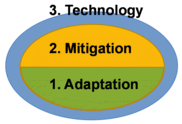Developing Countries
Benefits to developing countries start with the common but differentiated responsibility principle comprehensively fulfilled, at both collection and distribution points.
The scheme is also
- both global (as per the IMO)
- and differentiated (as per the UNFCCC) in that the regime applies only to the emissions associated with cargo destined for Annex I Parties (in the current regime)

- The benefit areas for developing countries include (assuming that only emissions attributable to Annex I countries are in scope):
- Adaptation: Major funding for adaptation to climate change in developing countries
- Estimated at $2.5bn+ per annum (assuming equal split of funds between mitigation and adaptation, and carbon market price of $30/tCO2)
- This innovative approach to reduce the gap in financing of adaptation seems essential. Thus far the international community has promised approximately $200m for adaptation measures, but the required funds are estimated at tens of $billions (circa 100:1 gap ratio)
- Estimated at $2.5bn+ per annum (assuming equal split of funds between mitigation and adaptation, and carbon market price of $30/tCO2)
- Mitigation: Significantly increased demand for REDD, CDM & JI projects
- The additional global demand estimated in excess of 150MtCO2 in 2012
- The current oversupply of CDM/JI drives the prices down, while lack of major funding does not stimulate REDD
- The additional global demand estimated in excess of 150MtCO2 in 2012
- Technology benefits
- Significant increase in financing of maritime R&D, estimated at $1bn (stimulation of innovation globally)
- Transfer of technologies to developing countries